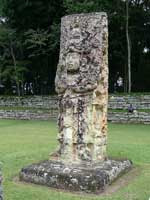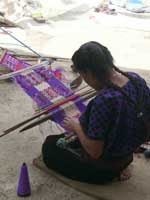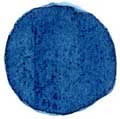The ancient Maya are well-known for their exotic, vibrant, appearances and practice of unusual body modifications. They exploited the materials available to them in their tropical environments to manufacture colorful textiles and striking ornamentation. They produced a wide range of outfits for different occasions, including lavish dress for large public events; vibrant dance costumes; protective armor for conflicts; sporting attire; and simpler, yet no less sophisticated, clothing for everyday situations
Events
During large public events, where the community would come together to witness the performance of rituals or other ceremonial duties, the ruling elite would wear large, lavish, outfits to reflect their important positions in society. These outfits would include large feathered headdresses, jade jewelry, and clothing made from the skins of dangerous animals (such as jaguars). Images of such lavish outfits are often seen on carved monuments set in public areas of ancient Maya sites, for all the community to see.
Pic 1: Stela H, Copan archaeological site, Honduras

Dance Costumes
Participants in celebratory dance events are often portrayed with very large costumes that encompass the body with an extravagant costume made of jade, feathers, and other exotic materials. In addition to large headdresses, dance participants often wore large backracks with long feathers. Despite the size of these costumes, they were designed to be light enough to move around with, so it is likely they had a light wooden frame onto which materials were attached
Pic 2

Protective Armor
The ancient Maya regularly participated in wars and conflicts and developed protective clothing as a means of defense. These outfits involved a padded mantle (perhaps made from twisted cotton or thick leaves), often covered with animal skin, and accouterments such as shields decorated with animal hide or feathers. Interestingly, ancient Maya scenes show war captives and prisoners stripped of much clothing and their ear jewelry replaced with strips of bark paper—which archaeologists take to be a sign of humiliation and defeat.
Pic 3: Ballgame scene, from a ceramic Maya vase (K1209)

Sporting Attire
The ballgame is a well-known Mesoamerican sport, and ballplayers wore specific and distinct attire. To reduce injury to the parts of the body which regularly came into contact with the hard rubber playing ball, a horseshoe-shaped yoke was worn around the waist and padding was worn around the knees and elbows. Scenes on painted pottery often show distinctive headdresses being worn to indicate which team a ballplayer belonged to
Everyday Clothing
Basic components of everyday dress included a loincloth or short skirt for men and a huipil or long skirt (perhaps paired with a quechquemitl) for women (see image to right). These outfits would often be embellished with jewellery such as bracelets and anklets, necklaces, and ear jewellery. Hairstyles were given much attention, and would be tied up (almost never left loose) and decorated with bands of fabric and long feathers. The ancient Maya show neatly maintained hairstyles in their art, suggesting that they may have put a stiffener in their hair to keep it in place.
Pic 4: Spindle and spindle whorl. Photo taken at Royal Ontario Museum, Toronto

How did they make their clothes?
Fabrics and Textiles
To make fabric from agave plants the Maya had to extract fibers from the leaves. To do this they had to soak or cook the leaves to tenderize them, which allowed fibers to be extracted and then dried in the sun. The fibers could be spun into threads of different thicknesses. Thicker threads may have been used to create a fabric that acted as a stiffener for belts or head ribbons. To make fabric from cotton plants, the cotton fiber has to be hand-picked from the plant and cleaned so it is clear and uniform. Then it must be prepared for spinning, in a process known as ginning, by beating the fiber to loosen it. Both cotton and agave fibers had to be spun into thread so that they could be woven into textiles. The ancient Maya used spindles and spindle whorls to do this (see pic 11). The spindle is a long stick that has a whorl attached to the end. Whorls could be made from clay, bone, or wood, and they are used to maintain or increase the speed of the spin. The spindle is turned with one hand while the other hand feeds the raw fiber to it with the supply over the shoulder or from a container on the ground.
Pic 5: Backstrap loom, San Juan Chamula, Mexico

Once spun, thread was woven into textiles using a backstrap loom like those that are still used by modern Maya today (see pic 12). The upper part of the loom can be tied to a stationary object such as a tree, and the lower part has a belt which is tied around the weaver’s waist. They are very light and portable and can be taken with the weaver wherever he/she travels. The looms are not very wide however so broad strips of cloth cannot be woven on them and several widths of cloth may have to be sewn together to create one piece of clothing. Similar to modern clothing worn by Maya women, ancient Maya textiles were not cut to shape and did not fit snugly to the body but were instead loosely draped around the body.
Pic 6: Extract of natural indigo applied to paper
Extract of natural indigo

Dyes and Colorants
The ancient Maya made colorful textiles from different colored threads. Since the natural color of agave and cotton fiber is white, yellow, or light brown, dyes were added to achieve other colors and were derived from plants, animals, and minerals. One of the most challenging natural dyes that the ancient Maya worked with was indigo. The blue color lies in the leaves of the indigo plant and has to be extracted by composting the leaves for months or by soaking them in water. The resulting paste has to be processed further because it is not soluble in water and can only dye fibers after it has been converted to its colorless reduced form by special bacteria, achieved by placing the indigo into an alkaline solution with other bacteria that consume the oxygen—the alkaline solution can be urine, and the bacteria can be rotting meat. When fabric is submerged in this final solution it turns yellowish-green but transforms to blue when it is removed and exposed to oxygen.
Pic 7: Dyeing with one of the last ancestral Purpura (murex) dyers on the planet on the coast of Oaxaca
 An easier natural dye that the ancient Maya worked with was that obtained from marine mollusks. Plicopurpura pansa were used to obtain a purple color, by crushing, boiling, or milking the shells to extract the dye. To milk the shell, the mollusk is poked with a pin or other implement until it releases drops of thick liquid. The liquid is a white-ish color but when it is applied to fibre and exposed to light and oxygen it turns to purple (see pic 7). Another dye that the ancient Maya obtained from a living organism was cochineal red. Female cochineal insects live on the leaves of cactus and they can be collected, dried, and crushed to produce dye ranging in color from orange, red, to purple. This dye is still used today in food and cosmetics, such as Starbucks beverages!
An easier natural dye that the ancient Maya worked with was that obtained from marine mollusks. Plicopurpura pansa were used to obtain a purple color, by crushing, boiling, or milking the shells to extract the dye. To milk the shell, the mollusk is poked with a pin or other implement until it releases drops of thick liquid. The liquid is a white-ish color but when it is applied to fibre and exposed to light and oxygen it turns to purple (see pic 7). Another dye that the ancient Maya obtained from a living organism was cochineal red. Female cochineal insects live on the leaves of cactus and they can be collected, dried, and crushed to produce dye ranging in color from orange, red, to purple. This dye is still used today in food and cosmetics, such as Starbucks beverages!